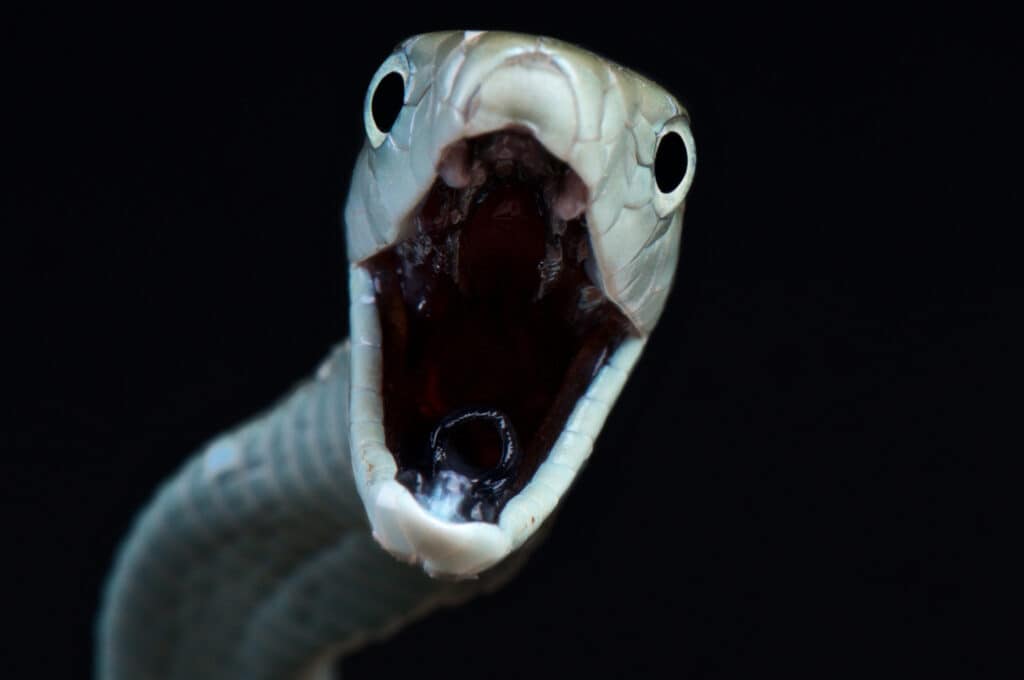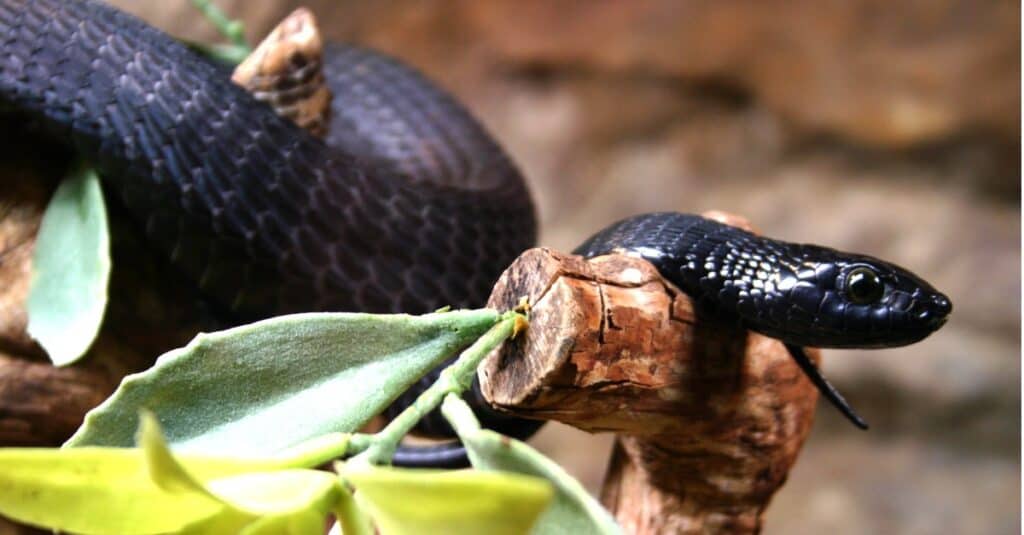Black Mambas are native to sub-Saharan Africa and can grow to a maximum of 14 ft. However, they’re usually from 6 feet 7 inches – 9 feet 10 inches, with an average of about 8.2 feet. This snake isn’t actually black. Instead, they’re a grey to dark brown color. The black color refers to the inside of their mouth (which is probably the last thing you want to see).
On top of being one of the largest venomous snakes in the world, this snake is also one of the fastest, slithering at up to 12.5 mph.
While that may seem quite large, this snake looks small compared to the anaconda, which can reach lengths of up to 29 feet. However, anacondas aren’t venomous.
The longest venomous snake in the world is the king cobra, which can grow up to 18 ft. However, king cobras are not nearly as fast as black mambas.
For comparison, the rattlesnake is one of the most common venomous snakes in North America, and it can grow up to 8 feet – much smaller than the black mamba. It is also slower.
Black Mamba vs…

You may be surprised at a black mamba’s size comparison to other animals.
©reptiles4all/Shutterstock.com
While the black mamba is a pretty large snack, it isn’t the longest in the world. The reticulated python and the green anaconda can both grow considerably longer than the black mamba.
For instance, the reticulated python can grow up to 16 feet relatively easily. Some rare examples even extend past 20 feet, making it much longer than the black mamba.
Surprisingly, the black mamba is about the same length as a male African lion, which measures an average of 8.2 feet from the tip of its nose to the base of its tail. However, makes can grow up to 10 feet long in some cases.
Bengal tigers are a bit longer than African lions and can reach up to lengths of 9.8 feet from head to tail. African elephants reach from 6 to 7 meters long, up to 23 feet. That’s much longer than a black mamba.
The average human adult’s height varies based on the population. However, the average height seems to be from 5.6 to 5.9 feet. Of course, that’s a general approximation, as humans vary a lot in height.
Either way that would make black mambas much longer than humans are tall.
Cars usually range from 14.8 feet to 16.4 feet for a typical mid-sized sedan. However, it does depend significantly on the make and model of the car. Black mambas probably won’t grow longer than a car, in any case.
Beds also range widely. Twin beds are about 6.2 feet long, while a king-size bed can be up to 7.2 feet long. That’s a bit shorter than the black mamba.
Please note that these size comparisons are approximate averages and can vary depending on the species or object being considered.
The Largest Black Mamba Snake Ever Recorded

The record for the largest black mamba is 14.43 feet.
©iStock.com/Nicole_Marschall
The largest black mamba snake ever recorded was 14.43 feet. This particular individual was found within the species’ natural range in Zimbabwe. It’s very odd for a snake to reach this size. However, it isn’t absolutely odd, as black mambas are large snakes, to begin with.
Luckily, black mambas are not aggressive. So, while they get very large, they aren’t out there hunting down people. This snake will defend itself when threatened, which is probably the last thing you want it to do. They are highly venomous, after all.
Black mambas are extremely toxic. They can kill a person with just two drops of venom, and many black mambas have up to 20 drops in their fangs. Therefore, they can easily kill a grown person with one bite. Their venom attacks both the nervous system and the heart.
A human can collapse within 45 minutes of a Black Mamba bite, so seeking medical attention immediately is essential.
Places You’re Most Likely to Encounter Black Mambas

Kenya, Uganda, and other areas of
Africa
are home to black mambas.
©Cormac Price/Shutterstock.com
Black mambas are native to sub-Saharan Africa and are found in several African countries. Southern and eastern Africa are the most common places to spot them. They are also found in areas such as Namibia, Botswana, Zambia, Tanzania, Kenya, and Uganda.
Their particular habitat varies widely, though. They may decide to live in savannas, woodlands, or rocky areas.
You’re most likely to find them in national parks and game reserves, which tend to have many suitable habitats. They can also be found in rural areas near human settlements, especially those located near their natural habitats. Farms and agricultural areas are pretty common, for instance.
You’ll likely find black mambas near rocky outcrops, cliffs, and even trees. They’re very good climbers so you may find them in unusual places. They are also known to inhabit abandoned termite mounds, which provide shelter and protection.
Woodlands are not safe, either, even though black mambas are mostly associated with forested regions. In areas where forests transition into open habitats, they may be particularly common.
It’s important to note that while black mambas are highly venomous and can be dangerous, they are generally shy and will usually avoid encounters with humans if given the opportunity.
However, if threatened or cornered, they may exhibit defensive behavior and become aggressive. If you are in an area where black mambas are known to inhabit, it is advisable to exercise caution and maintain a safe distance.
Discover the "Monster" Snake 5X Bigger than an Anaconda
Every day A-Z Animals sends out some of the most incredible facts in the world from our free newsletter. Want to discover the 10 most beautiful snakes in the world, a "snake island" where you're never more than 3 feet from danger, or a "monster" snake 5X larger than an anaconda? Then sign up right now and you'll start receiving our daily newsletter absolutely free.
Thank you for reading! Have some feedback for us? Contact the AZ Animals editorial team.








